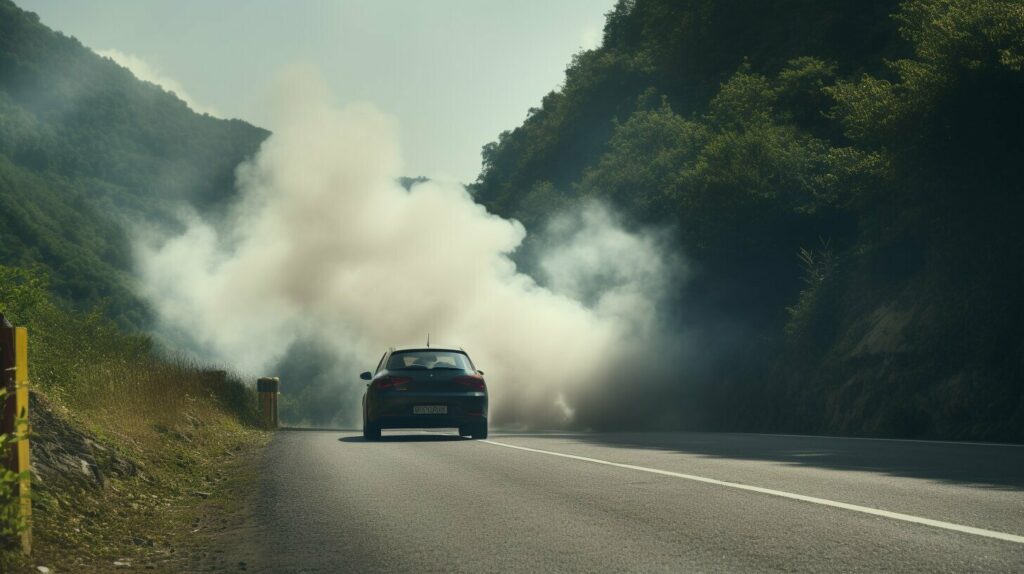Have you experienced a sputtering sensation when accelerating at low RPM in your car? This issue can be frustrating and dangerous if left unresolved. It’s essential to understand the possible causes and solutions to ensure a smoother driving experience.

In this section, we will explore the reasons behind a car sputtering when accelerating at low RPM. We will provide you with insights into the primary contributors to this issue and practical solutions to resolve it.
Key Takeaways:
- Car sputtering when accelerating at low RPM can be caused by engine misfire, fuel delivery problems, ignition system troubles, air intake blockages, exhaust system concerns, and sensor malfunctions.
- Proper diagnosis is crucial for resolving the sputtering issue.
- Once you have identified the cause of the sputtering, you can use practical solutions and fixes to restore your car’s smooth acceleration at low RPM.
Understanding Engine Misfire
If your car is sputtering when accelerating at low RPM, one possible reason is engine misfire. Engine misfire is when one or more cylinders fail to ignite properly, disrupting the engine’s performance. When this occurs, the engine may sputter, hesitate, or stall during acceleration or while driving.
There can be several causes of engine misfire, including:
- Faulty spark plugs or spark plug wires
- Defective ignition coil
- Clogged or malfunctioning fuel injectors
- Low fuel pressure due to a faulty fuel pump or clogged fuel filter
- Vacuum leaks
To diagnose engine misfire, you can use a scan tool to retrieve diagnostic trouble codes (DTCs) from the engine control module (ECM). These codes can help identify the specific cylinder or component causing the misfire. You can also perform a visual inspection of the spark plugs, ignition coils, and fuel injectors to check for signs of damage or wear.
Once you have identified the cause of the misfire, you can take the appropriate steps to resolve the issue. This may involve replacing faulty components, cleaning or replacing clogged fuel injectors or filters, or repairing vacuum leaks. In some cases, a simple tune-up may be all that is needed to restore proper engine performance.
By understanding engine misfire and its potential causes, you can take the necessary steps to address your car’s sputtering issue and enjoy a smoother driving experience.
Fuel Delivery Problems
If your car is sputtering when accelerating at low RPM, fuel delivery problems could be the culprit. There are several potential sources of fuel delivery issues that can cause your car to behave this way. These can include:
| Problem | Symptom |
|---|---|
| Clogged fuel filter | Inconsistent engine performance |
| Fuel pump malfunction | Loss of engine power |
| Dirty fuel injectors | Poor fuel efficiency |
The above problems can be diagnosed through various methods, including fuel pressure tests and visual inspections of the fuel system components. If you suspect fuel delivery issues, it is important to address them promptly to avoid further damage to your car’s engine.
There are several solutions to fuel delivery problems, depending on the specific issue. For example, if you’re dealing with a clogged fuel filter, the filter can be replaced relatively easily. Fuel pump malfunction might require a more involved fix, such as replacing the pump entirely. Dirty fuel injectors can be treated with an injector cleaning solution or may need to be replaced entirely.
If you’re not comfortable tackling fuel delivery issues yourself, it’s best to take your car to a qualified mechanic who can properly diagnose and fix the problem. With the right expertise and tools, fuel delivery problems can be resolved, and your car’s acceleration performance can be restored.
Ignition System Troubles
If your car sputters when accelerating at low RPM, the ignition system could be to blame. The ignition system is responsible for producing and delivering the electrical spark that ignites the fuel in the engine. If there is an issue with any of the components, it can cause misfire and result in sputtering during acceleration.
Common ignition system problems include:
| Issue | Symptoms |
|---|---|
| Spark plug problems | Difficulty starting, rough idling, reduced acceleration, misfire |
| Ignition coil failure | Engine misfire, poor fuel economy, difficulty starting |
| Distributor issues | Engine misfire, stalling, difficulty starting |
If you suspect an issue with your ignition system, it is essential to diagnose the problem before attempting any repairs. A comprehensive diagnostic test using a scan tool can help identify the specific component causing the sputtering.
Once you have identified the problematic component, you can replace it with a new one. In some cases, cleaning or adjusting the component may be sufficient to restore smooth acceleration at low RPM.
Overall, addressing ignition system troubles requires a basic understanding of the components and how they function together. If you are uncomfortable performing any of the diagnosis or repairs yourself, it is best to seek the assistance of a professional mechanic.
Air Intake Blockages
One of the possible causes of your car sputtering when accelerating at low RPM is a blockage in the air intake system. The air intake system is responsible for delivering air to the engine, which is essential for the combustion process.
There are several potential blockages that can occur in the air intake system:
- Dirty air filter: Over time, the air filter can become clogged with dirt and debris, reducing the amount of air that reaches the engine.
- Throttle body issues: The throttle body controls the amount of air that enters the engine. If it becomes dirty or malfunctions, it can disrupt the air-fuel mixture and cause sputtering.
- Intake manifold gasket leak: The intake manifold gasket is responsible for sealing the intake manifold to the engine. If it becomes damaged or fails, it can result in a vacuum leak, which can cause sputtering.
To diagnose a blockage in the air intake system, you can start by visually inspecting the air filter and the throttle body. If you notice any dirt or debris, you can clean them using specialized air intake cleaners.
If the issue persists, you may need to replace the air filter or the throttle body. In more severe cases, you may need to repair or replace the intake manifold gasket.
Keeping your air intake system clean and well-maintained can help prevent blockages and ensure that air is flowing smoothly to your engine. This can help you avoid sputtering and enjoy a smoother driving experience.
Exhaust System Concerns
If your car is sputtering when accelerating at low RPM, it’s possible that the exhaust system is the culprit. The exhaust system is responsible for filtering out harmful gases and reducing engine noise. Issues with this system can cause sputtering and poor engine performance.
One potential problem is a clogged catalytic converter. This critical component helps to convert harmful exhaust gases into less harmful ones. If it becomes clogged, it can obstruct the flow of exhaust gases, leading to sputtering and reduced power.
Another potential issue is an exhaust leak. A leak in the exhaust system can allow gases to escape before they are properly filtered, leading to decreased engine performance and sputtering.
Finally, problems with the muffler can also contribute to sputtering. The muffler is responsible for reducing engine noise and can become damaged or clogged, leading to decreased performance and sputtering during acceleration at low RPM.
If you suspect that your exhaust system is causing your car to sputter when accelerating at low RPM, it’s crucial to address the issue promptly. A damaged catalytic converter, exhaust leak, or muffler can lead to more significant problems if left untreated.
Consulting with a qualified mechanic is recommended, as they can inspect your exhaust system and diagnose any issues. They can also provide recommendations on potential fixes, such as replacing a damaged catalytic converter, fixing a leak, or replacing a damaged muffler.
Sensor Malfunctions
If your car is sputtering when accelerating at low RPM, malfunctioning sensors may be the culprit. The oxygen sensor and mass airflow sensor are two of the most common sensors that can cause this issue. These sensors monitor the amount of oxygen and air entering the engine and adjust the fuel injection accordingly.
If the sensors fail, your car may experience a lean or rich air-fuel mixture, which can cause sputtering. To diagnose sensor malfunctions, you can use a scan tool to check for trouble codes. Additionally, you can perform a visual inspection of the sensors to see if there are any signs of damage or wear.
If you identify a malfunctioning sensor, you will need to replace it. Consult your car’s manual or a trusted mechanic for instructions on how to do this properly.
Note:
You should always use high-quality sensors when replacing them. Low-quality sensors may not function properly and can cause further issues down the line.
Diagnosis Techniques
When your car sputters during acceleration at low RPM, it’s crucial to diagnose the issue correctly. Here are some diagnostic techniques that can help:
Use a Scan Tool
A scan tool, also known as an OBD-II (On-Board Diagnostics) scanner, can help you retrieve error codes from your car’s computer. These codes can provide valuable information about the underlying issue, such as a misfire in a specific cylinder or a malfunctioning sensor. Scan tools are available for purchase or rental at auto parts stores.
Perform Visual Inspections
A visual inspection can help you identify some common causes of sputtering, such as loose or damaged wires, worn-out spark plugs, or clogged air filters. Check the engine compartment thoroughly, looking for any signs of damage or wear.
Conduct Component Tests
Component tests involve checking specific parts of the engine and ignition system to determine if they are functioning correctly. For example, you can use a multimeter to test the voltage output of the ignition coil or perform a fuel pressure test to check if the fuel pump is working properly.
Remember to observe safety precautions when conducting these tests. If you’re unsure about performing any diagnostic technique, consult a professional mechanic.
Solutions and Fixes
Now that you have identified the cause of your car’s sputtering, it’s time to resolve the issue. Here are some practical solutions and fixes to help you get your car running smoothly again:
Engine Misfire
If engine misfire is the cause of your sputtering, you may need to replace your spark plugs, ignition coils, or other ignition system components. Make sure to use high-quality replacement parts and follow the manufacturer’s instructions for installation.
Fuel Delivery Problems
If you have a clogged fuel filter or malfunctioning fuel pump, replacing these components may solve the issue. Cleaning your fuel injectors can also improve your car’s performance. Alternatively, you could use a fuel system cleaner to remove any buildup and improve fuel delivery.
Ignition System Troubles
If your ignition system is the culprit, you may need to replace your spark plugs, ignition coils, or distributor. Check for any signs of wear or damage and replace any faulty components. You may also need to adjust the timing or ignition settings.
Air Intake Blockages
To fix air intake blockages, start by cleaning or replacing your air filter. Check your throttle body for any signs of wear or damage and clean it if necessary. You may also need to replace any damaged hoses or sensors in the air intake system.
Exhaust System Concerns
If your catalytic converter is clogged or damaged, you may need to replace it. Check for any leaks in your exhaust system and repair them if necessary. You may also need to replace a damaged muffler or resonator.
Sensor Malfunctions
If your oxygen sensor or mass airflow sensor is faulty, you may need to replace it. Check for any signs of wear or damage and replace any faulty sensors. You may also need to clean or replace any other sensors that may be contributing to the issue.
Remember to always use high-quality replacement parts and follow the manufacturer’s instructions for installation. If you’re not confident in your ability to fix the issue yourself, don’t hesitate to seek professional help.
Conclusion
In conclusion, experiencing a sputtering car when accelerating at low RPM is a frustrating issue that can be caused by several factors. Understanding the potential causes, such as engine misfire, fuel delivery problems, ignition system troubles, air intake blockages, exhaust system concerns, and sensor malfunctions, is crucial to addressing the problem.
By using diagnostic techniques, like visual inspections and component tests, you can identify the specific cause behind your car’s sputtering issue. Once you have identified the problem, you can use the appropriate solutions, such as cleaning air filters, replacing spark plugs, or fixing exhaust leaks, to restore your car’s smooth acceleration at low RPM.
Keep in mind that some sputtering issues can be remedied with simple fixes, while others may require more complex repairs. If you’re unsure about how to diagnose or fix your car’s sputtering problem, it’s always best to consult with a professional mechanic.
Remember, keeping up with your car’s regular maintenance, such as changing your oil and replacing your air filter, can help prevent sputtering issues from occurring in the first place.
Thank you for taking the time to read this guide on sputtering cars when accelerating at low RPM. We hope that the information provided has been helpful in addressing this frustrating problem.


